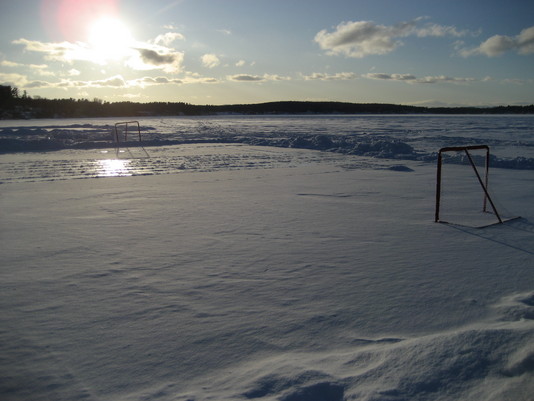After dumping a record 32 inches on our county last weekend, Mother Nature doubled her punishment by following up the Nor’easter with a weekend deep freeze. Most folk greeted the descending mercury with a teeth-chattering grumble. But then, most folk weren’t trying to build a hockey rink on the lake.
Those of us who were saw the turn in temperature as a sign from the gods. As we learned on the first attempt, flooding the rink for a smooth surface should only be attempted in below-freezing temperatures. With arctic air blowing down from the north, we bundled up and took to our project with renewed spirits.
Keenly aware that our neighbor would also be resuming his rink construction, we quickly contacted our tractor-driving neutral neighbor and had the 32 inches of snow plowed from our rink. With a layer of slush exposed, we used the electric pump to re-flood the surface, hoping that the lake water would be warm enough to melt the slush before freezing.
Hypothesized Reasons why Attempt #2 Failed:
1) The rink is being built too close to land. (Not sure why this would contribute to failure, but it’s been thrown out there).
2) The freezing slush left air pockets in the ice, causing the new layer to form an uneven, thin veneer which cracked and broke under the slightest pressure.
3) We are cursed.
Reason #2 appears to be the front-runner. Whatever the actual cause, our flooding-during-freezing method didn’t take. The new pumped layer froze quickly enough, but the slush underneath proved an unreliable substrate.
An interesting side note, which may provide hope for attempt #3: Curiously, the entire frozen sections of the bay–which are almost all covered by a foot or more of snow–all have about a two-inch layer of slush in between the snow and the ice. This is curious because the bay had been completely frozen over when the snow fell, and it’s been below freezing since. So where did the slush come from?
Our wise, neutral neighbor–who has lived on the lake for many moons–claims it is the weight of the snow, pressing down on the ice, causing the water underneath to rise up through cracks in the ice. With some insulation provided by the snow, the water that comes to the surface turns to slush.
Why does this provide hope? Maybe the water being forced up through the cracks will fill in all the air pockets in our rink and freeze, providing a firmer, more reliable substrate upon which we may attempt one final layer of ice.
If it doesn’t work, we’re buying a rink-building kit.
Stay tuned!




























